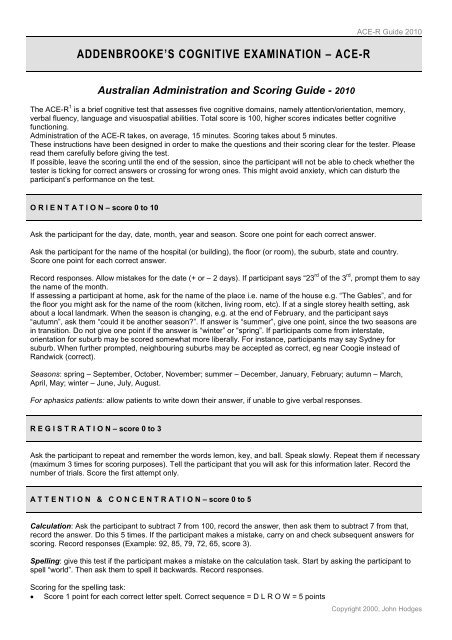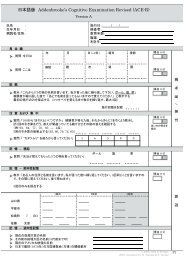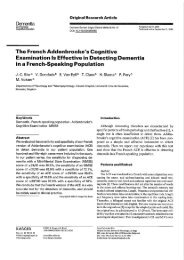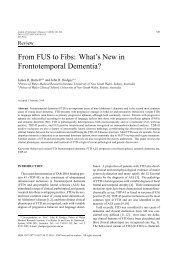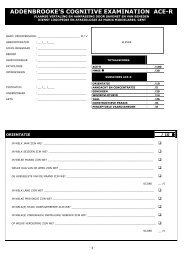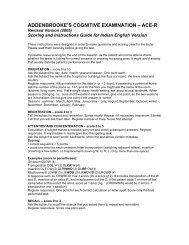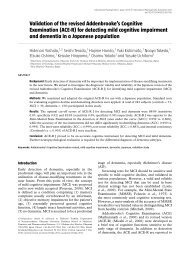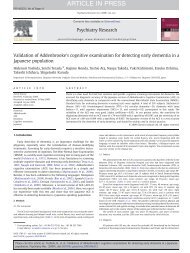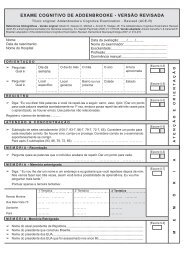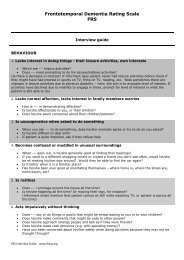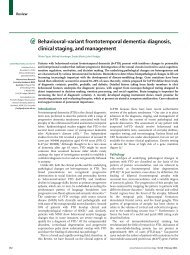ADDENBROOKE'S COGNITIVE EXAMINATION – ACE-R
ADDENBROOKE'S COGNITIVE EXAMINATION – ACE-R
ADDENBROOKE'S COGNITIVE EXAMINATION – ACE-R
Create successful ePaper yourself
Turn your PDF publications into a flip-book with our unique Google optimized e-Paper software.
ADDENBROOKE’S <strong>COGNITIVE</strong> <strong>EXAMINATION</strong> <strong>–</strong> <strong>ACE</strong>-R<br />
Australian Administration and Scoring Guide - 2010<br />
<strong>ACE</strong>-R Guide 2010<br />
The <strong>ACE</strong>-R 1 is a brief cognitive test that assesses five cognitive domains, namely attention/orientation, memory,<br />
verbal fluency, language and visuospatial abilities. Total score is 100, higher scores indicates better cognitive<br />
functioning.<br />
Administration of the <strong>ACE</strong>-R takes, on average, 15 minutes. Scoring takes about 5 minutes.<br />
These instructions have been designed in order to make the questions and their scoring clear for the tester. Please<br />
read them carefully before giving the test.<br />
If possible, leave the scoring until the end of the session, since the participant will not be able to check whether the<br />
tester is ticking for correct answers or crossing for wrong ones. This might avoid anxiety, which can disturb the<br />
participant‟s performance on the test.<br />
O R I E N T A T I O N <strong>–</strong> score 0 to 10<br />
Ask the participant for the day, date, month, year and season. Score one point for each correct answer.<br />
Ask the participant for the name of the hospital (or building), the floor (or room), the suburb, state and country.<br />
Score one point for each correct answer.<br />
Record responses. Allow mistakes for the date (+ or <strong>–</strong> 2 days). If participant says “23 rd of the 3 rd , prompt them to say<br />
the name of the month.<br />
If assessing a participant at home, ask for the name of the place i.e. name of the house e.g. “The Gables”, and for<br />
the floor you might ask for the name of the room (kitchen, living room, etc). If at a single storey health setting, ask<br />
about a local landmark. When the season is changing, e.g. at the end of February, and the participant says<br />
“autumn”, ask them “could it be another season?”. If answer is “summer”, give one point, since the two seasons are<br />
in transition. Do not give one point if the answer is “winter” or “spring”. If participants come from interstate,<br />
orientation for suburb may be scored somewhat more liberally. For instance, participants may say Sydney for<br />
suburb. When further prompted, neighbouring suburbs may be accepted as correct, eg near Coogie instead of<br />
Randwick (correct).<br />
Seasons: spring <strong>–</strong> September, October, November; summer <strong>–</strong> December, January, February; autumn <strong>–</strong> March,<br />
April, May; winter <strong>–</strong> June, July, August.<br />
For aphasics patients: allow patients to write down their answer, if unable to give verbal responses.<br />
R E G I S T R A T I O N <strong>–</strong> score 0 to 3<br />
Ask the participant to repeat and remember the words lemon, key, and ball. Speak slowly. Repeat them if necessary<br />
(maximum 3 times for scoring purposes). Tell the participant that you will ask for this information later. Record the<br />
number of trials. Score the first attempt only.<br />
A T T E N T I O N & C O N C E N T R A T I O N <strong>–</strong> score 0 to 5<br />
Calculation: Ask the participant to subtract 7 from 100, record the answer, then ask them to subtract 7 from that,<br />
record the answer. Do this 5 times. If the participant makes a mistake, carry on and check subsequent answers for<br />
scoring. Record responses (Example: 92, 85, 79, 72, 65, score 3).<br />
Spelling: give this test if the participant makes a mistake on the calculation task. Start by asking the participant to<br />
spell “world”. Then ask them to spell it backwards. Record responses.<br />
Scoring for the spelling task:<br />
Score 1 point for each correct letter spelt. Correct sequence = D L R O W = 5 points<br />
Copyright 2000, John Hodges
<strong>ACE</strong>-R Guide 2010<br />
Count one error for each omission, letter transposition (switching adjacent letters), insertion (inserting a new<br />
letter), or misplacement (moving W, O, R, L, D by more than one space).<br />
Examples (score in parentheses):<br />
omission transposition insertion misplacement<br />
omission DLOW (4)<br />
transposition DOLW (3) DLORW (4)<br />
omission transposition insertion misplacement<br />
insertion DLTOW (3) DLRWWO (3) DLRROW(4)<br />
misplacement LOWD (3) LRWOD (3) LRWOWD (3) LROWD (4)<br />
A response such as „LRWWOD‟ has 3 errors (L and R are correct, for a score of 2). It includes transposition of the W<br />
and O, insertion of an extra W, and misplacement of the D. If the patient adds 1 or more of the same letter at the end<br />
of the word, count as one error (e.g. „ LDROWWW, would be 2 errors, 1 transposition and 1 addition).<br />
Score one point for each correct calculation or letter spelt. Score only the better performed one.<br />
R E C A L L <strong>–</strong> score 0 to 3<br />
Ask the participant to recall the words that you asked them to repeat and remember.<br />
Record responses. Score one point for each correct item.<br />
Anterograde Memory <strong>–</strong> score 0 to 7<br />
Instruct the participant: “I‟m going to read you a name and address that I‟d like you to repeat after me. We‟ll be doing<br />
that 3 times, so you have a chance to learn it. I‟ll be asking you about it later”. If the participant starts repeating along<br />
with you, ask them to wait until you give it in full.<br />
Record responses for each trial. However, only the third score contributes to the <strong>ACE</strong>-R score (0-7points).<br />
Retrograde Memory <strong>–</strong> score 0 to 4<br />
Ask the participant for the name of the current Prime Minister, the current Premier of NSW (or equivalent if the<br />
person is from a different state of Australia), the president of the US and the president of the US who was<br />
assassinated in the sixties.<br />
Score one point each. Allow answers like Rudd, Gillard, Keneally; Obama; Kennedy. Do not accept answers like<br />
Kevin, ask for surname as well. Answers such as “Jeff Kennedy” or “Barry Rudd” would be scored incorrect.<br />
Note if there has been a very recent change in leaders, probe for the name of the outgoing politician.<br />
V E R B A L F L U E N C Y <strong>–</strong> score 0 to 14<br />
Letters <strong>–</strong> score 0 to 7<br />
Instruct the participant: “I‟m going to give you a letter of the alphabet and I‟d like you to generate as many words as<br />
you can beginning with that letter, but not the names of people or places. Are you ready? You‟ve got a minute and<br />
the letter is P”.<br />
Participant might repeat or perseverate words, e.g. pay, paid, pays. Record and count them for the overall total<br />
number of responses but do not consider them for the final score. In the same way, intrusions such as words<br />
beginning with other letters are recorded but not scored. Proper names (Peter, Peterborough) do not count. For<br />
plurals e.g. pot, pots, total = 2, correct = 1. Use the table provided on the <strong>ACE</strong>-R sheet to obtain the final score for<br />
this test.<br />
Animals <strong>–</strong> score 0 to 7<br />
Instruct the participant: “Now can you name as many animals as possible, beginning with any letter?”<br />
Copyright 2000, John Hodges
<strong>ACE</strong>-R Guide 2010<br />
Participant might repeat words. Record and count them for the overall total number of responses, but they should<br />
not be considered for the final score. The participant may misunderstand and perseverate by naming animals<br />
beginning with “p”. Repeat instructions during the 60 seconds if necessary.<br />
If subject says e.g. “fish”, and later says “salmon” and “trout”, count and record as 3 for “total” but do not accept “fish”<br />
as correct (count only 2 out of the 3, e.g. “salmon” and “trout”). However, if only the category is given, e.g. fish, with<br />
no specific exemplars, then count fish as 1 for total and final correct responses. The same applies to mammals,<br />
reptiles, birds, breeds of dog, insects, etc.<br />
L A N G U A G E - Comprehension (Close your eyes) <strong>–</strong> score 0 or 1<br />
Instruct the participant: “Read this sentence and do as it says”. If the participant reads sentence aloud but does not<br />
follow the instructions, score 0.<br />
L A N G U A G E - Comprehension (3-stage command) - score 0 to 3<br />
Instruct the participant: “Take this paper in your right hand, fold it in half, and put it on the floor”. Do not allow<br />
participant to take the paper before you have finished giving the complete instruction.<br />
Score one point for each correct command, e.g. if participant takes the paper and puts it on the floor without folding,<br />
score 2; if participant takes the paper in their right hand, and folds it several times and leaves on the table, score 1.<br />
L A N G U A G E - Writing <strong>–</strong> score 0 or 1<br />
Instruct the participant to write a sentence.<br />
The sentence should contain a subject and a verb, and it should have a meaning.<br />
Do not accept “Happy Birthday” or “Nice day” as a sentence. If participant has difficulty thinking of something to<br />
write, prompt gently with “What‟s the weather like today?”<br />
L A N G U A G E - Repetition <strong>–</strong> score 0 to 2<br />
Ask the participant to repeat the words after you. Say one word at a time. Circle the words that were repeated<br />
incorrectly. Consider first attempt only for scoring. Record responses. Score 2 if all words are correct; 1 if 3 are<br />
correct; 0 if 2 or less are correct.<br />
L A N G U A G E - Repetition <strong>–</strong> score 0 to 2<br />
Ask the participant to repeat each sentence. Do not accept partially correct repetitions, e.g. “no ifs and buts”, “above<br />
below” as correct for scoring. Score one point for each sentence.<br />
L A N G U A G E - Naming <strong>–</strong> score 0 to 2<br />
Naming (watch and pencil)<br />
Ask the participant to name each picture. Correct answers: pencil; wristwatch or watch.<br />
L A N G U A G E - Naming <strong>–</strong> score 0 to 10<br />
Naming (5 animals and 5 objects)<br />
Ask the participant to name each picture. Correct answers: penguin; anchor; camel or dromedary; barrel, keg, or tub;<br />
crown; crocodile or alligator; harp; rhinoceros or rhino; kangaroo or wallaby; piano accordion, accordion or squeeze<br />
box.<br />
Score one point each.<br />
Copyright 2000, John Hodges
L A N G U A G E - Comprehension <strong>–</strong> score 0 to 4<br />
Comprehension<br />
Ask the participant to point to the pictures according to the statement read.<br />
Score one point each. Allow self-corrections.<br />
L A N G U A G E - Reading <strong>–</strong> score 0 or 1<br />
<strong>ACE</strong>-R Guide 2010<br />
Ask the participant to read the words aloud. Score one point only if all five words are correctly read. Record the<br />
mistakes using the phonetic alphabet if possible.<br />
V I S U O S P A T I A L A B I L I T I E S - Overlapping pentagons <strong>–</strong> score 0 or 1<br />
The pentagons should clearly show 5 sides and the intersection.<br />
Score 0<br />
Score 1<br />
V I S U O S P A T I A L A B I L I T I E S - Wire Cube <strong>–</strong> score 0 to 2<br />
Cube should have 12 lines = score 2, even if the proportions are not perfect. A score of 1 is given if cube has fewer<br />
than 12 lines, but general cube shape is maintained. See examples below.<br />
Copyright 2000, John Hodges
Score 1<br />
Score 2<br />
V I S U O S P A T I A L A B I L I T I E S - Clock <strong>–</strong> score 0 to 5<br />
<strong>ACE</strong>-R Guide 2010<br />
Ask the participant to draw a clock face with the numbers on it. When he/she has finished, ask them to put the hands<br />
at “ten past five”. If participant does not like their first drawing and would like to do it again, you can allow for that and<br />
score the second clock; participants may correct their mistakes by erasing it while drawing.<br />
Circle<br />
Numbers<br />
Hands<br />
Score 2<br />
1 point maximum if it is a reasonable circle<br />
2 points if all included and well distributed<br />
1 point if all included but poorly distributed<br />
0 points if not all included<br />
2 points if both hands are well drawn, different lengths and placed on correct numbers (you might ask<br />
which one is the small and big one)<br />
1 point if both placed on the correct numbers but wrong lengths OR<br />
1 point if one hand is placed on the correct number and drawn with correct length OR<br />
1 point if only one hand is drawn and placed at the correct number i.e. 5 for „ten past five‟<br />
Circle (1); one hand placed correctly (1)<br />
Circle (1); all the numbers but not placed inside the circle<br />
(1)<br />
Copyright 2000, John Hodges
Score 3<br />
Circle (1); all the numbers but not<br />
proportionally distributed (1), one hand<br />
placed correctly (1)<br />
Score 4<br />
Circle(1); numbers proportionally<br />
distributed (2); one hand placed<br />
correctly (1)<br />
Score 5<br />
Circle (1), all the numbers but not<br />
placed inside the circle (1), one hand<br />
place correctly (1).<br />
Circle (1); all the numbers but not<br />
proportionally distributed (1); both<br />
hands placed correctely (2)<br />
<strong>ACE</strong>-R Guide 2010<br />
Circle (1), note that numbers are<br />
not inside the circle and there<br />
are 2 number 10s (0), hands<br />
placed correctly<br />
Circle (1); numbers<br />
proportionally distributed (2), one<br />
hand placed correctly (1)<br />
Circle (1); numbers proportionally distributed on both halves of the clock face (2); hands placed correctly (2)<br />
Copyright 2000, John Hodges
P E R C E P T U A L A B I L I T I E S <strong>–</strong> score 0 to 4<br />
Counting dots<br />
Participant is not allowed to point to the picture. Score one point for each correct answer.<br />
Correct answers, from top left clockwise: 8, 10, 9 and 7.<br />
P E R C E P T U A L A B I L I T I E S <strong>–</strong> score 0 to 4<br />
Identifying letters<br />
Participant is allowed to point to the picture. Score one point for each correct answer.<br />
Correct answers, from top left clockwise: K, M, T and A.<br />
<strong>ACE</strong>-R Guide 2010<br />
For aphasic patients: if the patient is unable to say the letter name, allow them to identify the letters by writing them<br />
out, or saying the letter sound that matches (e.g “mmmm”)<br />
R E C A L L <strong>–</strong> score 0 to 7<br />
Recall<br />
Say to the participant: “Now tell me what you remember of that name and address we were repeating at the<br />
beginning”. Tick and score one point for each item recalled, using the score guide provided in the test.<br />
Example 1a<br />
Harry Bond<br />
78 Market Street<br />
Rockingham<br />
….<br />
Example 2a<br />
Harry Barnes<br />
73 Rockhampton Street<br />
….<br />
Queensland<br />
Example 3a<br />
Harry Bond<br />
33 Hampton Way<br />
Rockhampton Street<br />
Cambridge<br />
Queensland<br />
R E C O G N I T I O N <strong>–</strong> score 0 to 5<br />
Harry Barnes<br />
73 Market Street<br />
Rockhampton<br />
Queensland<br />
1 + 0<br />
0 + 1 + 1<br />
0<br />
0<br />
1 + 1<br />
1 + 0 + 1<br />
0<br />
1<br />
1 + 0<br />
0 + 0 + 0<br />
0 + 0<br />
0<br />
1<br />
Score 3/7<br />
Score 5/7<br />
Score 2/7<br />
Recognition <strong>–</strong> only to be given if participant fails to recall one or more items in the recall task.<br />
This task should be given to allow the participant a chance to recognise items that he or she could not recall. If the<br />
participant recalls the name and address correctly, this test is not needed and the participant scores 5. However,<br />
many participants will recall only parts. Start by ticking the correctly remembered items on the shadowed column<br />
(right hand side) and then tell them “Let me give you some hints. Was the number (or whatever was forgotten or<br />
mistaken) x, y or z?” and so on. Every recognised item scores one point. Maximum score is 5. Adding recalled items<br />
to those recognised gives the final score for this part of the test.<br />
Copyright 2000, John Hodges
Example 1b (based on example 1a)<br />
Tester ticks “Market Street” on the right hand side<br />
shadowed column because participant had recalled<br />
that item. The tester should then ask:<br />
- Was it Jerry Barnes, Harry Barnes or Harry<br />
Bradford?<br />
- Was it 37, 73 or 76?<br />
- Was it Margate, Rockhampton or Cairns ?<br />
- Was it Queensland, New South Wales or Victoria?<br />
Example 2b (based on example 2a)<br />
Tester ticks “Harry Barnes”, “73” and “Queensland” on<br />
the right hand side shadowed column because<br />
participant had recalled those items. The tester should<br />
then ask:<br />
- Was it Market Road, Martin Street or Market<br />
Street?<br />
- Was it Margate, Rockhampton or Cairns?<br />
Example 3b (based on example 3a)<br />
Tester ticks “Queensland”, on the right hand side<br />
shadowed column because participant had recalled<br />
that item. The tester should then ask:<br />
- Was it Jerry Barnes, Harry Barnes or Harry<br />
Bradford?<br />
- Was it 37, 73 or 76?<br />
- Was it Market Road, Martin Street or Market<br />
Street?<br />
- Was it Margate, Rockhampton or Cairns?<br />
M M S E <strong>–</strong> score 0 to 30<br />
Participant‟s<br />
answers:<br />
Harry Barnes<br />
76<br />
Rockhampton<br />
New South Wales<br />
Participant‟s<br />
answers:<br />
Market Street<br />
Rockhampton<br />
Participant‟s<br />
answers:<br />
Jerry Barnes<br />
37<br />
Martin Street<br />
Cairns<br />
1<br />
0<br />
1<br />
0<br />
+ 1 (Market Street)<br />
1<br />
1<br />
+ 3 (Harry Barnes, 73,<br />
Queensland)<br />
0<br />
0<br />
0<br />
0<br />
+1 (Queensland)<br />
<strong>ACE</strong>-R Guide 2010<br />
Score 3/5<br />
Score 5/5<br />
Score 1/5<br />
The MMSE score can be obtained by adding up the scores in the shaded boxes to the right hand side of each test.<br />
N O R M A T I V E D A T A<br />
A total of 326 subjects (England and Australia), consisting of three groups: a dementia group (n=142), a mild<br />
cognitive impairment group (n=36) and a control group (148).<br />
Table 1: <strong>ACE</strong>-R total and sub-scores according to age (50-59, 60-69, 70-79), showing control means (standard<br />
deviations in brackets). This sample includes English and Australian controls; there were no significant differences<br />
between their scores, which were combined below.<br />
Copyright 2000, John Hodges
Age range Education<br />
(years)<br />
50-59<br />
(n=33)<br />
60-69<br />
(n=64)<br />
70-79<br />
(n=51)<br />
13.79<br />
(3)<br />
13.35<br />
(2.3)<br />
12.87<br />
(3.4)<br />
Total<br />
<strong>ACE</strong>-R<br />
score<br />
95.82<br />
(3.8)<br />
94.45<br />
(3.2)<br />
93.78<br />
(3.9)<br />
Attention/<br />
Orientation<br />
17.82<br />
(0.4)<br />
17.78<br />
(0.5)<br />
17.73<br />
(0.5)<br />
Memory Fluency Language<br />
<strong>ACE</strong>-R Guide 2010<br />
Visuospatial<br />
Table 2: Sensitivity, Specificity and Positive Predictive Values (PPV) at different prevalence rates of two cut-off total<br />
<strong>ACE</strong>-R scores. Values in parenthesis represent the respective Negative Predictive Values 1<br />
Dementia<br />
24.67<br />
(2.1)<br />
23.89<br />
(1.7)<br />
23.57<br />
(2.3)<br />
12.15<br />
(1.4)<br />
12.00<br />
(1.7)<br />
12.12<br />
(1.5)<br />
25.55<br />
(0.9)<br />
25.13<br />
(0.9)<br />
24.82<br />
(1.4)<br />
PPV at different prevalence rates<br />
<strong>ACE</strong>-R cut-off Sensitivity Specificity 5% 10% 20% 40%<br />
C L I N I C A L I N T E R P R E T A T I O N<br />
88 0.94 0.89 0.31 (1.0) 0.48 0.68 0.85 (1.0)<br />
82 0.84 1.00 1.0 (0.96) 1.0 1.0 1.0 (0.90)<br />
Cut offs<br />
Two cut-offs are recommended, 88 for screening, and 82 for research purposes.<br />
Sensitivity to dementia<br />
At the low cut-off of 82, the <strong>ACE</strong>-R has high sensitivity (84%), excellent specificity (100%), and very good predictive<br />
values on a wide range of dementia prevalence [1]. The cut-off at 88 offers even better sensitivity (94%), but the<br />
trade-off is the lower specificity, when a number of false positives can be generated (controls scoring below 88 but<br />
above 82).<br />
To overcome the grey zone between the two cut-off scores, a table of likelihood ratios was developed. For each<br />
given score between 88 and 82, a likelihood ratio of dementia was given. For instance, a score of 88 yields a chance<br />
of 8.4%, whereas a score of 82 yields a 100% chance of having dementia. This interpretation should, however, be<br />
combined with standard clinical assessment and corroboration from an informant of progressive decline from a<br />
previous level of functioning.<br />
Studies involving patients with mild cognitive impairment (MCI) have shown that the <strong>ACE</strong> is very sensitive to early<br />
stages of dementia, and can also predict those who are likely to convert to dementia [2-3]. A recent study[3] has<br />
shown that those scoring above 88 at baseline did not convert to dementia at the 2-year follow-up visit [3].<br />
Table 3: Likelihood ratios for probability of dementia at various <strong>ACE</strong>-R cut-off scores[1]<br />
<strong>ACE</strong>-R score<br />
Likelihood ratio of dementia<br />
88 8.43<br />
87 11.5<br />
86 14.2<br />
85 18.9<br />
84 27.6<br />
83 52.5<br />
82 100<br />
15.64<br />
(0.9)<br />
15.63<br />
(0.8)<br />
15.57<br />
(0.8)<br />
Copyright 2000, John Hodges
<strong>ACE</strong>-R Guide 2010<br />
Differential diagnosis<br />
Because the <strong>ACE</strong> assesses several cognitive domains, it is possible to derive profiles of cognitive impairment that<br />
can be used in differential diagnosis. We will present some possible interpretations below.<br />
Differentiating Alzheimer’s Disease from frontotemporal dementia (FTD)<br />
The <strong>ACE</strong> can reliably differentiate between Alzheimer‟s Disease (AD) and FTD with a simple ratio. The VLOM ratio,<br />
which is composed by the scores of verbal fluency + language/orientation + memory (recall of name and address<br />
only) yields a ratio that can help differentiating AD from FTD patients. This ratio basically shows that relative high<br />
scores on verbal fluency and language, with low scores on orientation and memory is typical of AD, with the opposite<br />
being true for FTD (See [4] for more information). On the revised version, a VLOM ratio of < 2.2 could differentiate<br />
FTD from AD (sensitivity of 58% and specificity of 95%), whereas a VLOM ratio of >3.2 could differentiate AD from<br />
FTD (sensitivity of 74% and specificity of 85%) [1, 4].<br />
The <strong>ACE</strong> can also distinguish between behavioural variant FTD (bvFTD) from psychiatric syndromes that mimic<br />
bvFTD, such as the subgroup recently termed phenocopy bvFTD [5-8]. A study showed that true bvFTD (those with<br />
documented atrophy on initial MRI, and who deteriorate to stage of nursing home care, have clear cognitive decline<br />
on the <strong>ACE</strong>, whereas those with phenocopy bvFTD show no change on the <strong>ACE</strong> over a long period of time,<br />
paralleling control performance [9].<br />
More specifically, the <strong>ACE</strong> can be used to discriminate between AD and semantic dementia using a simple<br />
algorithm, the semantic index. The rationale behind the semantic index lies on the significant group differences on<br />
<strong>ACE</strong> sub-scores for naming, reading and orientation in time. The semantic index is composed by (naming + reading)<br />
<strong>–</strong> (serial 7s scores + orientation in time and drawing). The possible range is therefore +14 to -15 [10]. Although this<br />
index has not yet been validated in the revised <strong>ACE</strong>, it has potential clinical application in differentiating patients with<br />
AD and SD, especially in the context of SD patients presenting with low scores on verbal memory tests and, as a<br />
result, being misdiagnosed with AD.<br />
Different cognitive profiles in atypical Parkinsonian syndromes<br />
More recent work has shown that the <strong>ACE</strong> is valuable in the assessment for patients with atypical Parkinsonian<br />
syndromes such as corticobasal degeneration (CBD), and progressive supranuclear palsy (PSP), each of which<br />
produces distinct cognitive profiles. Bak [11-12] showed that CBD patients have overall poor performance on all <strong>ACE</strong><br />
sub-scores, equivalent to that seen in AD. The progressive supranuclear palsy (PSP) group produces impaired<br />
fluency but much better performance than CBD patients (See [11] for more information). In this same study,<br />
sensitivity and specificity of the MMSE and <strong>ACE</strong> were compared, establishing <strong>ACE</strong>‟s superiority. The MMSE was<br />
shown to be inadequate to detect cognitive impairment in subcortical syndromes.<br />
Dementia and affective disorder<br />
The <strong>ACE</strong> can also be very helpful in discriminating between patients with affective disorders from those with<br />
dementia. “Pure” affective disorder patients score significantly higher than AD or FTD patients. More interestingly,<br />
the <strong>ACE</strong> is able to predict those who could develop dementia in a mixed group. Dudas [13] showed that patients with<br />
affective symptoms primarily (with a probable progressive-degenerative disorder, as well as patients with suspected<br />
dementia concomitant with an affective disorder) and that eventually developed dementia, could be distinguished by<br />
their baseline <strong>ACE</strong> scores. All of those who later developed dementia had scored below 88 two years prior to the<br />
clear onset of the neurodegenerative disease.<br />
Conclusions<br />
When interpreting scores on cognitive tests such as the <strong>ACE</strong>, it is important to bear a number of issues in mind.<br />
Scores on tests should not be used in isolation. The <strong>ACE</strong> is not a conclusive diagnostic test of dementia, it is rather<br />
a tool that can aid the clinician in making a diagnosis as well as in differentiating dementias. Several conditions can<br />
cause cognitive impairment, therefore clinical judgement should prevail [14]. Finally, the criteria for diagnosis of<br />
dementia state that patients should present with cognitive impairment sufficient to impair everyday life activities. It is<br />
crucial, therefore, to ascertain impairment on activities of daily living (ADLs) as well as level of cognitive decline in<br />
suspected dementia. It is well established in AD that changes in everyday function are associated with cognitive<br />
dysfunction [15-17], but in FTD cognitive assessment in isolation can overestimate abilities [18-19].<br />
Also, other important issues are related to cut-off scores and premorbid education. Many countries have been<br />
validating the <strong>ACE</strong> for their own population, so it is crucial that cut-offs are used accordingly. A large study using the<br />
old <strong>ACE</strong> in India revealed marked differences in scoring for each educational level [20].<br />
A final aspect in interpretation should be noted in terms of prevalence. All <strong>ACE</strong> and <strong>ACE</strong>-R studies, to date, were<br />
conducted within settings with high prevalence of dementia. When using the <strong>ACE</strong> in a community sample, one<br />
should keep in mind that community samples have a much lower rate of prevalence in comparison to specialised<br />
centres. A major disadvantage is that the <strong>ACE</strong>, to date, has not been validated against a community sample [21].<br />
The <strong>ACE</strong>-R has been used in over 40 countries (Argentina, Australia, Austria, Belgium, Bosnia & Herzegovina,<br />
Brazil, Canada, Chile, China, Cuba, Czech Republic, Denmark, Egypt, England, France, Germany, Greece, Holland,<br />
Hong Kong, Hungary, India, Indonesia, Iran, Ireland, Israel, Italy, Japan, Mexico, New Zealand, Northern Ireland,<br />
Paraguay, Poland, Portugal, Qatar, Romania, Saudi Arabia, Scotland, Slovenia, South Africa, South Korea, Spain,<br />
Switzerland, Thailand, Turkey, Uruguay and USA), and in 28 languages to date.<br />
Copyright 2000, John Hodges
R E F E R E N C E S<br />
<strong>ACE</strong>-R Guide 2010<br />
1. Mioshi, E., et al., The Addenbrooke's Cognitive Examination Revised (<strong>ACE</strong>-R): a brief cognitive test battery for<br />
dementia screening. International Journal of Geriatric Psychiatry, 2006. 21(11): p. 1078-1085.<br />
2. Galton, C.J., et al., A Comparison of the Addenbrooke's Cognitive Examination (<strong>ACE</strong>), Conventional<br />
Neuropsychological Assessment, and Simple MRI-Based Medial Temporal Lobe Evaluation in the Early Diagnosis of<br />
Alzheimer's Disease. Cogn Behav Neurol, 2005. 18(3): p. 144-150.<br />
3. Mitchell, J., et al., Outcome in subgroups of mild cognitive impairment (MCI) is highly predictable using a simple<br />
algorithm. J Neurol, 2009.<br />
4. Mathuranath, P.S., et al., A brief cognitive test battery to differentiate Alzheimer's disease and frontotemporal<br />
dementia. Neurology, 2000. 55(11): p. 1613-20.<br />
5. Kipps, C.M., et al., Combined magnetic resonance imaging and positron emission tomography brain imaging in<br />
behavioural variant frontotemporal degeneration: refining the clinical phenotype. Brain, 2009.<br />
6. Kipps, C.M., et al., Understanding social dysfunction in the behavioural variant of frontotemporal dementia: the role<br />
of emotion and sarcasm processing. Brain, 2009. 132(Pt 3): p. 592-603.<br />
7. Davies, R.R., et al., Progression in frontotemporal dementia: identifying a benign behavioral variant by magnetic<br />
resonance imaging. Arch Neurol, 2006. 63(11): p. 1627-31.<br />
8. Kipps, C.M., et al., Behavioural variant frontotemporal dementia: not all it seems? Neurocase, 2007. 13(4): p. 237-47.<br />
9. Kipps, C.M., et al., Measuring progression in frontotemporal dementia: Implications for therapeutic interventions.<br />
Neurology, 2008. 70(22): p. 2046-52.<br />
10. Davies, R.R., et al., Differentiation of semantic dementia and Alzheimer's disease using the Addenbrooke's Cognitive<br />
Examination (<strong>ACE</strong>). Int J Geriatr Psychiatry, 2008. 23(4): p. 370-5.<br />
11. Bak, T.H., et al., Cognitive bedside assessment in atypical parkinsonian syndromes. J Neurol Neurosurg Psychiatry,<br />
2005. 76(3): p. 420-2.<br />
12. Bak, T.H., et al., Subcortical dementia revisited: similarities and differences in cognitive function between progressive<br />
supranuclear palsy (PSP), corticobasal degeneration (CBD) and multiple system atrophy (MSA). Neurocase, 2005.<br />
11(4): p. 268-73.<br />
13. Dudas, R.B., G.E. Berrios, and J.R. Hodges, The Addenbrooke's cognitive examination (<strong>ACE</strong>) in the differential<br />
diagnosis of early dementias versus affective disorder. Am J Geriatr Psychiatry, 2005. 13(3): p. 218-26.<br />
14. Mioshi, E. and J.R. Hodges, Commonly used cognitive screening instruments for diagnosis of dementia. Journal of<br />
Internal Medicine Concepts and Practice (Mandarin), 2009. 4: p. 247-250.<br />
15. Feldman, H., et al., The disability assessment for dementia scale: a 12-month study of functional ability in mild to<br />
moderate severity Alzheimer disease. Alzheimer Dis Assoc Disord, 2001. 15(2): p. 89-95.<br />
16. Galasko, D., J. Corey-Bloom, and L.J. Thal, Monitoring progression in Alzheimer's disease. J Am Geriatr Soc, 1991.<br />
39(9): p. 932-941.<br />
17. Suh, G.H., et al., A longitudinal study of Alzheimer's disease: rates of cognitive and functional decline. Int J Geriatr<br />
Psychiatry, 2004. 19(9): p. 817-24.<br />
18. Mioshi, E., et al., Activities of daily living in frontotemporal dementia and Alzheimer disease. Neurology, 2007. 68(24):<br />
p. 2077-84.<br />
19. Mioshi, E., C.M. Kipps, and J.R. Hodges, Activities of daily living in behavioral variant frontotemporal dementia:<br />
differences in caregiver and performance-based assessments. Alzheimer Dis Assoc Disord, 2009. 23(1): p. 70-6.<br />
20. Mathuranath, P.S., et al., Mini mental state examination and the Addenbrooke's cognitive examination: effect of<br />
education and norms for a multicultural population. Neurol India, 2007. 55(2): p. 106-10.<br />
21. Cullen, B., et al., A review of screening tests for cognitive impairment. J Neurol Neurosurg Psychiatry, 2007. 78(8): p.<br />
790-9.<br />
Copyright 2000, John Hodges


